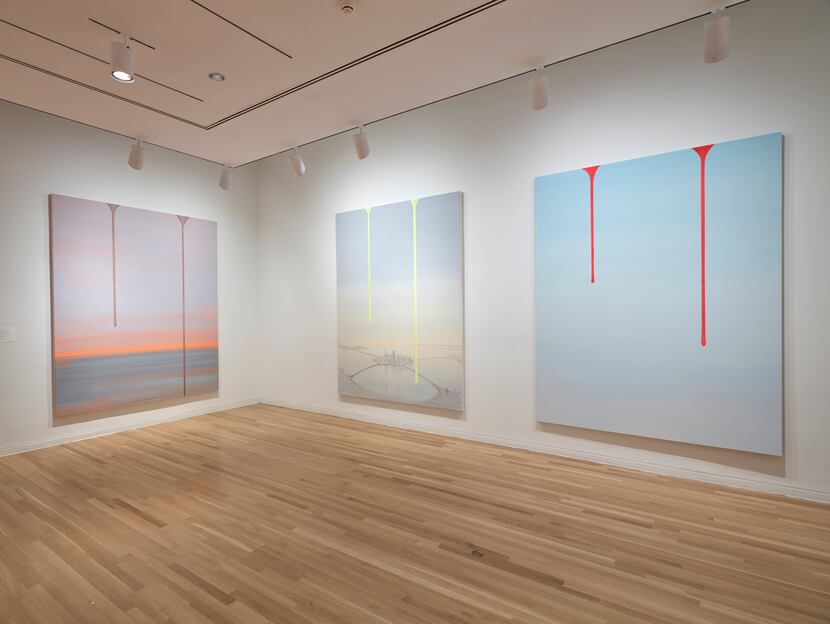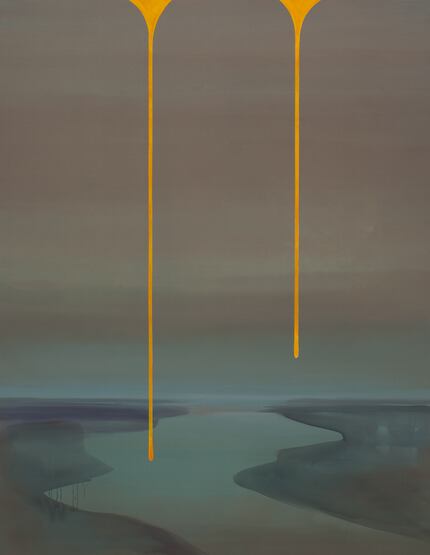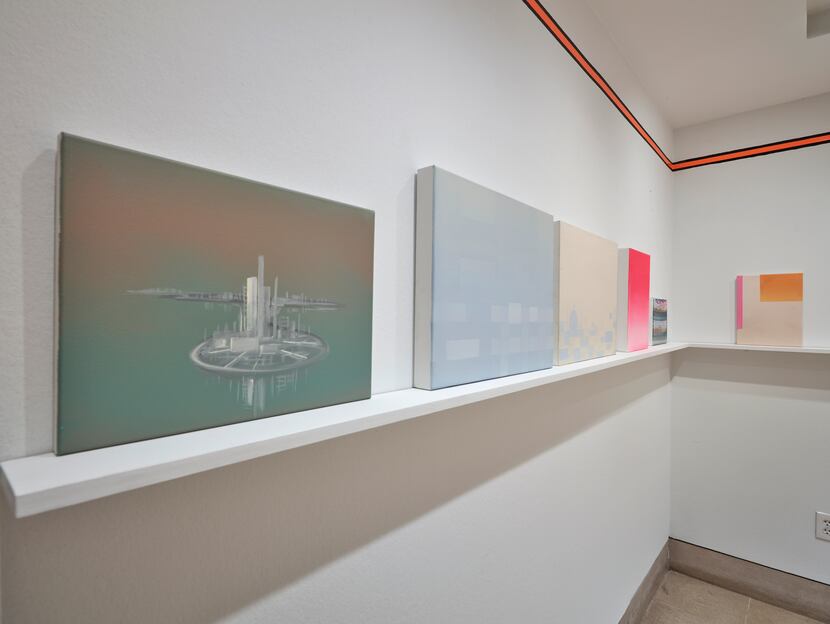If you stand in the center of the gallery and slowly turn 360 degrees for an overall view of the work in “Wanda Koop: Dreamline,” you will find yourself surrounded by a symmetrical, ordered display of two paintings on each wall, repeating with perfect regularity to create an overall eight-part enclosure.
Whichever direction you look, you will see two side-by-side paintings, each 11 feet tall and 7 feet wide, and scaled to perfectly fit within the room at the Dallas Museum of Art. There is about a foot of space between the bottom of each canvas and the floor, and about the same distance from the top of the paintings to the gallery’s dropped ceiling.
The regularity and tranquility of the space might recall the Rothko Chapel in Houston, another sanctuary of modern painting divided symmetrically into eight parts. Indeed, Koop suggests that this project has a spiritual dimension, drawing on the sense that the experience of dreams and of nature can reveal deeper, hidden truths.

The paintings in Koop’s “Dreamline” series (all painted this year) are all variations on the same theme: a landscape rendered in lush, otherworldly colors, with a low horizon visible in the distance through a thick atmosphere. From the top of each painting, there descend two side-by-side drips, which the artist calls “tears,” abruptly breaking the illusion of distance with their immediate presence and contrasting colors.
Any two of the paintings in the series can show these contrasts. For example, the snowy white grid in Spill suggests a cold winter stillness, under which cultivated land, planted with grain, will eventually bring forth a crop of life-giving food — even as the black drips above it suggest the much more lucrative crop of oil hidden deeper underground. By comparison, the deep, dark, hypnotic blue in Seeway (whose idea originated on the Saint Lawrence Seaway) suggests the endless motion of the sea: romantic but dangerous, whether carrying navigators to far-off lands or threatening its cold, drowning depths. And the sky blue of Look Up, with tinges of gray and lavender, suggests the view from an ascending aircraft, rising through the clouds.

Koop’s bewitching way with color is the first thing that will grab your attention as you enter the gallery. She creates depth by using layer upon layer of paint (as many as 10, in the case of Capitol). Her unusual color palette goes back to her days in art school, when she witnessed fellow students from Hong Kong, unusually, bringing neon pink and green into their paintings, and was inspired to broaden her choices of color.
The most jarring moments of color in “Dreamline” are the twin “tears” that fall from the top of each painting: the neon orange tears in River, or the day-glow yellow-green tears in Satellite City. They function as insistent reminders of the artwork’s human-made nature, something she describes as “cutting through the surface of the painting.”
Although her colors extend beyond the range of the natural, Koop’s vision is rooted in the natural world. Many of her compositions originate with a view of a riverbank, by the side of which indigenous people have lit fires according to their ancient tradition. This vision suggests rhythms of life and nature that predate modern colonialism and environmental degradation. Koop considers herself an activist and is a strong supporter of indigenous and environmental causes, such as the Dakota Access Pipeline protests. In 1998, she founded a community arts center, called Art City, to serve Winnipeg’s inner-city indigenous youths.
Surrounded by the vast Western Canadian prairie, Winnipeg has an economy that’s strongly influenced by the carbon-intensive business of oil and gas extraction. In such respects, the depicted environment will seem familiar to viewers in Texas. Looking at the bright-red glow of the sky in Capitol, one might think of the burning fires that power the modern economy, whether natural gas flaring off from oil wells or the sparks within a billion internal-combustion engines.

Koop, 68, has lived and worked for most of her life in Winnipeg, where she graduated from the University of Manitoba. She moved there with her parents, Russian Mennonite immigrants, after spending her early years in Vancouver, British Columbia, where she was born. She has always had a sense of identification with the outsider, after her family’s wealth vanished in the Russian Revolution and they had to start over, from nothing, in a new and strange country.
She began painting as a child and never stopped. She uses her dreams as a source of inspiration, working out the details through small black-and-white notes made after she wakes up.
“Dreamline” combines the centuries-old genre of landscape painting with a 21st-century sense of environmental responsibility. Indeed, Koop shares a sense of dismay, even despair, about the future of the planet, lending a dark undercurrent to her works. Koop calls this work “a beautiful lament for the planet.”

But she is not without hope. Although, she says, “unless something changes, the future can be seen as very bleak,” she allows that, “If we can reforest our world and put a moratorium on a lot of the things we’re doing, the world will heal itself.” Committed to her vocation, she adds, “The only hope is art.” The paintings in “Dreamline” allow one to contemplate both possible futures: doom or renewal.
This is the 62nd in the Dallas Museum of Art’s “Concentrations” series, which typically offers the first U.S. solo museum exhibition of a given artist — an occasion for celebration. Moreover, this is only the latest welcome example of curator Katherine Brodbeck’s successful effort to show a fully international selection of contemporary art, with recent and upcoming exhibitions of Minerva Cuevas (Mexico), Sandra Cinto (Brazil) and Ragnar Kjartansson (Iceland).
This installment of “Concentrations,” however, is particularly special, because the artist created the paintings specifically for this show and conceived them to be displayed in the museum’s Focus II Gallery, where they fit perfectly. The overall regularity of the eight-part series brings out the subtle contrasts among them: for example, the blood-red glow surrounding the building in Capitol vs. the chilly white of Spill. The paintings are so absorbing that it is easy to forget the somewhat claustrophobic nature of the gallery that holds them (only one doorway, and no windows).
Although there isn’t room here for a full survey of Koop’s career, the museum does offer an ingenious way of introducing viewers to a range of her work. Before entering the main gallery, viewers pass through a smaller room. Here, 26 of Koop’s smaller, preparatory works are perched on a shelf that runs around three of the four walls, underneath a fluorescent orange line that Koop has painted on the wall, running above and parallel to the shelf. The selection of paintings serves as a kind of library of her oeuvre.

Unlabeled, these works nevertheless offer clues as to the origin of some of the artist’s ideas, which are fully fleshed out in the “Dreamline” series. They offer a small taste of the artist’s already long and productive career, and they whet the viewer’s appetite for much more, now that Koop has finally been given her well-deserved U.S. museum debut.
Benjamin Lima is a Dallas-based art historian and the editor of Athenaeum Review, the University of Texas at Dallas journal of arts and ideas.
Details
“Concentrations 62: Wanda Koop, Dreamline” runs until Feb. 2 at the Dallas Museum of Art, 1717 N. Harwood St., Dallas. 11 a.m. to 5 p.m. Tuesday through Sunday; 11 a.m. to 9 p.m. Thursday. Free. 214-922-1200. dma.org.

